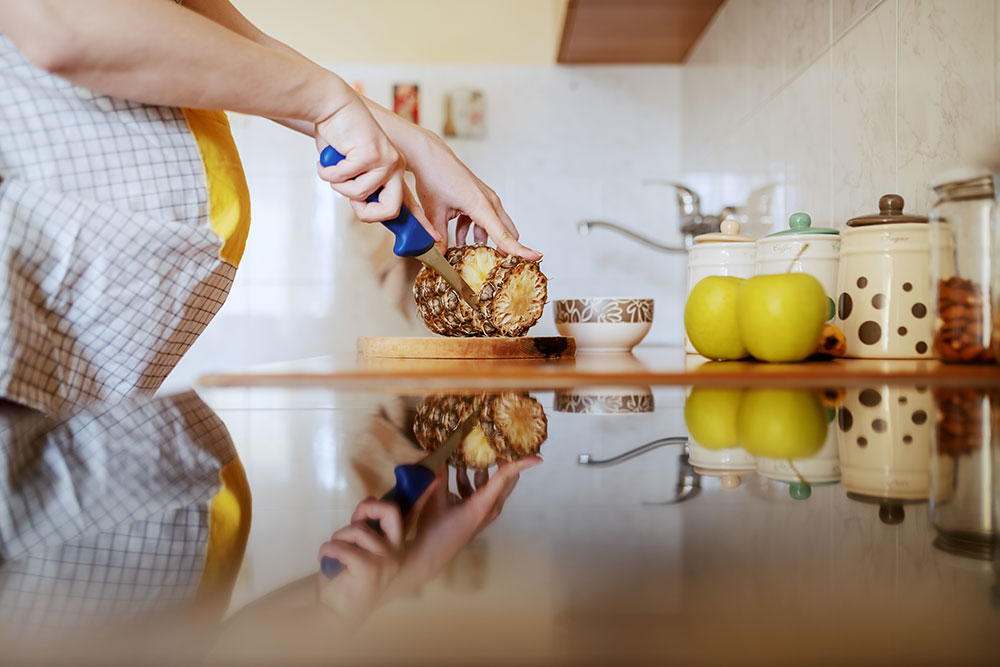5 Natural Ways To Encourage Labor

These at-home methods may prime your body for birth and increase efficiency once labor is underway.
When you’re eagerly awaiting your due date, you might be inclined to do what you can to kick-start your baby’s departure from the home you’ve graciously provided for the 40-or-so weeks. While little research suggests you can prompt spontaneous labor to begin at home, you can do things to ready and ripen your cervix (where the cervix softens, thins out, and shortens in prep for labor), increase oxytocin levels (the hormone that causes contractions), and then work with your body to bring on better contractions once they start. In addition to the well-known old wives’ tales, like eating spicy foods and sexual intercourse (hey, we’re still willing to try), give these at-home methods a whirl and see where they take you—hopefully to the delivery room!
Eat Pineapple
While searching for natural methods to start labor, you’ve probably come across consuming eggplant and caster oil, but what about this tropical treat? For best results, your pineapple must be fresh and raw, so put the canned variety back in the pantry and head to the grocery store to pluck one from the produce aisle. Pineapple doesn’t actually initiate contractions, but it does contain an enzyme called bromelain that is believed to help boost cervical ripening and shorten stages of labor, which goes hand-in-hand with cervical dilation.
Drink Raspberry Leaf Tea
This herbal beverage is thought to increase blood flow to the uterus, strengthening the muscle fibers needed to contract during labor. Stronger muscles equal more effective contractions—and possibly a shorter, stronger labor. Red raspberry leaf tea also contains antioxidant and anti-inflammatory properties, making it beneficial to your overall health during late pregnancy and postpartum. But be advised, birthing parents should avoid drinking the tea until after 37 weeks of pregnancy because of its softening effects on the cervix, which can lead to preterm labor.
Nipple Stimulation
As awkward as it sounds, this is the only method with backed scientific data. In response to the nipples being rubbed and rolled, your body releases oxytocin, which helps start contractions. If you’re up for giving it a go, the idea is to mimic the feeling of a newborn suckling. (We’ve heard some parents-to-be also break out the breast pump for this.) However, note that it’s crucial to be full-term (37 weeks or more) before considering this option, and you should have your health care provider give you the green light beforehand.
Bouncing
Gently bouncing on a birthing ball with your legs spread apart allows your pelvis to stay open and engaged. This is believed to encourage your tiny tenant to move down in the birth canal, where the pressure from their head on the cervix assists with ripening and dilation. This motion can also relieve tension from the lower back and be used as a pain management tool during early labor. If you’re not into bouncing, you can get similar effects from climbing stairs or curb-walking, where you walk with one leg on the curb and one on the road. Just be careful not to wear yourself out too early—you’ve still got a baby to deliver.
Get an Enema
This follows the same age-old train of thought of drinking castor oil to stimulate your bowels and trigger labor, but an enema fortunately doesn’t come with the same dreadful laxative side effect. The idea is that by emptying your bowels, you cause the surrounding muscles to contract, which could spark uterine contractions. But, to us, it sounds like a lot of unpleasant physical work for a non-guaranteed result. On the flip side, you’ll worry less about pooping during labor. (Spoiler alert: It happens all the time and is totally normal.) Of course, you’ll want to loop in your provider beforehand if considering using an enema and heed their advice on whether it’s a good idea for your pregnancy.
The important thing to remember is that babies come when they’re ready; there’s no definite way to induce labor without the use of medical induction methods, such as Pitocin (and even those sometimes don’t do the trick). While it can be downright painful by the end of pregnancy, try not to rush the remainder of your prenatal journey. You’ll be united with your long-awaited newbie soon enough, and the slow-ticking clock will be a thing of your past.
Please note that some products listed are linked to affiliate websites and we may collect a small commission on your purchase.







